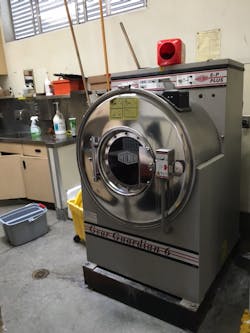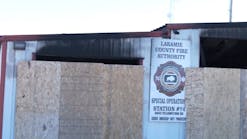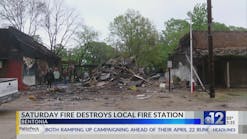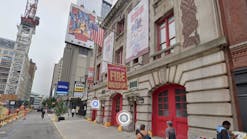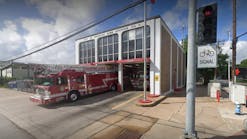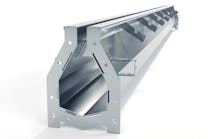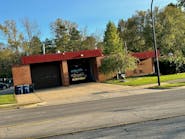Choosing a laundry system for the firehouse can be almost as time consuming as choosing a fire truck. The main difference being one doesn’t have wheels; otherwise they are both complicated pieces of machinery that make demands on the building and the people who operate them.
I am not going to tell you which machine to buy. I’m going to tell you how this equipment affects the building and vice versa. My experience comes from spending a third of my career on the design and construction of 11 new firehouses and countless remodels.
For our purposes, I am only talking about commercial laundry equipment. As most of you have probably learned already, residential equipment does not last long in an active firehouse. A more important reason is in the next paragraph.
Since you are thinking about cleaning your gear in house, I assume you have already read NFPA 1851, Chapter 7 – Cleaning & Decontamination. Section 7.3.7 Advanced Cleaning & Decontamination deals with machine washing. If you haven’t read it, take a few minutes now. It’s only two-and-a-half pages long. Go ahead, read it now. I’ll wait.
Now that you know the why, let’s talk about the what and where. These machines are called washer/extractors. This is because the drum spins at very high speed to extract most of the water from the material.
Your first step is to decide how you want to manage the turnout cleaning process. Is your department small enough that it can be handled by one machine at one location or big enough that you will need multiple machines and/or machines at multiple firehouses? This will also help determine what size machine to buy. If everyone has two sets, it is a little easier to rotate the gear through the cleaning station. The major manufacturers all build a model designed to comply with NFPA 1851. Fire service-rated machines go from 40- to 140-pound capacity. That’s from one to about a dozen sets of turnouts.
Regardless of the factors above, the decision will still be driven by the budget. Lucky for us, the manufacturers provide financing. This is safety equipment. It is an investment in your future. Properly cleaned PPE can reduce your exposure to carcinogens.
Placing washers in new fire stations
If you are building a new firehouse, this is a much easier process. You can design for the washer/extractor you want. It is important to pick your machine before the building is designed. Actually, it is important to have all your equipment picked out early in the design process. Then the space can be made to fit them; not the other way around. You have to give the architect the specification sheet(s) or "cut sheets" for each item.
The smallest machines have a footprint similar to a residential washer on a pedestal. The big ones have footprints five or six feet on its longest side and can be six feet tall, not counting the piping above it. They all need additional space around them for maintenance clearances.
There are Adjacency Rules for designing a firehouse. Certain rooms belong next to each other, others don’t. Sometimes it is a matter of function. Other times it is a matter of noise.
You want to place the device away from the living space. The far side of the apparatus bay is appropriate. A second consideration for placement is not to have it under sleeping spaces—discuss between yourselves if that also means the day room. The laundry room is best placed on an exterior wall. If venting is required by the manufacturer, this will make the installation easier and save a little money on ductwork. Since the turnout room belongs over there too, having these two spaces adjacent makes sense.
The smaller extractors are bolted to the concrete floor through a steel frame. The bigger machines are mounted to a reinforced, raised, concrete base. They need to be anchored due their weight and to the high torque the spinning drum creates. Weights go from 750 to 2,400 pounds.
You can expect the machines to spin at close to 500 rpm. This keeps it under the 100 G-force rule in NFPA 1851.
Utility considerations
The machines come in a variety of voltage, amperage and electrical phasing. The units come in the standard 120v/single phase, 208v single or three phase up to 480v/three-phase. Of course, three-phase power has to be already onto your site. Check with the local electrical company. Three-phase is better for electrical motors if it is available because it has less wear and tear.
Plumbing is another consideration. Some units require an open vent in the drain line; others need an open concrete trench to drain the machine. This insures the machine cannot clog and backup. The trench will take up more square footage in the room. More square footage equals more cost. Clustering the laundry, janitorial space and the decon room will shorten plumbing runs and cut costs. You are putting in a decon room, right?
Laundry area in existing stations
An existing firehouse limits your choices. Fortunately, the manufacturers have developed machines that do not need the concrete base. They are wrapped in energy absorbing frames. This solves several problems, but they still weigh the same. The floor still needs to be strong enough to handle the weight. Obviously, they shouldn’t go upstairs in an older wood-frame firehouse. Besides, how would you get it up there?
Finding the best space for the machine may be a challenge. You are still looking for the best room away from the living space that can carry the weight. The utilities can be challenging in a retrofit. The sanitary sewer is the most important utility you have to address. Since it is underground it is the hardest to move. You have to go to it. That open trench will complicate the plumbing installation if that is the model you buy. Water supply can be run from another part of the building. Ideally, the electrical room is near but can be further away and conduit and wire can be run to the machine for a price. Moving the sewer more than a couple of feet is expensive.
Not all departments buy dryers. Many just air-dry the gear. NFPA 1851 and funding will guide your decision here. Some departments build their own low-volume, low-heat drying systems.
Go to the major manufacturers' websites and compare the equipment. They have plenty of information regarding the models, operation, utility connections and installation procedures. Make a list of questions. Contact the companies and get answers. The ones I’ve spoken to are happy to help.
You will also find information regarding NFPA 1851 and other items of interest to the fire service.
The last deciding factor may be, “How close is the nearest service representative?”
Finally, I don’t know about your department, but our department rulebook was a “reactionary document.” Rules were only in there because someone made a mistake. Following is a particular section of NFPA 1851: "7.3.10.2 – Helmets shall not be machine cleaned or dried using equipment that produces mechanical action by tumbling or agitation."
Other sections say the same thing about gloves and footwear! Really, what was someone thinking?
As I say to all my clients, “you need to make an informed decision."
JIM MCCLURE, a retired fire captain from California, spent a third of his career involved in the design and construction of firehouses. He founded Firehouse Design & Construction to assist fire departments and architects in the design and build of maintainable, durable and functional fire stations.
